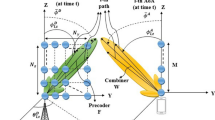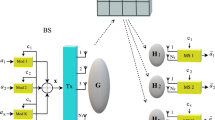Abstract
The mitigation of interference is an ubiquitous problem in wireless communication systems for which a number of signal processing techniques have been developed. This problem is made more critical in the presence of an increased numbers of interfering cells, interfering users and antennas, as it is the case in massive MIMO systems. As a consequence, the conventional methods see their performance degrades. In this paper, we propose to incorporate Oblique Projection (OP) with conventional ZF beamforming in the downlink of a massive MIMO communication system and investigate the achievable data rate at the reception. Resulting beamformer uses oblique projection spaces to separate the received signal into two subspaces: the one pertaining to the desired user signal and the other to interference signals, thus achieving a high degree of interference suppression. It is shown that the OP beamforming performs better than Maximum Ratio Transmitting (MRT) and the transmit MMSE beamforming counterparts.




Similar content being viewed by others
REFERENCES
J. Hoydis, S. Ten. Brink, and M. Debbah, “Massive MIMO: How many antennas do we need?” in Communication, Control, and Computing (Allerton), (Proc. 49th Annual Allerton Conf. IEEE, 2011) (IEEE, New York, 2011), pp. 545–550.
F. Rusek, D. Persson, B. K. Lau, E. G. Larsson, T. L. Marzetta, O. Edfors, et al., “Scaling up MIMO: Opportunities and challenges with very large arrays,” IEEE Signal Processing Mag. 30, 40–60 (2013).
T. L. Marzetta, G. Caire, and M. Debbah, I. Chih. Lin, and S. K. Mohammed, “Special issue on massive MIMO”, J. Commun Networks 15, 333–337 (2013).
F. Boccardi, R. W. Heath, A. Lozano, T. L. Marzetta, and P. Popovski, “Five disruptive technology directions for 5G,” IEEE Commun. Mag. 52, 74–80 (2014).
T. S. Rappaport, S. Sun, R. Mayzus, H. Zhao, Y. Azar, K. Wang, et al., “Millimeter wave mobile communications for 5G cellular: It will work,” IEEE Access, No. 1, 335–349 (2013).
J. G. Andrews, S. Buzzi, W. Choi, S. V. Hanly, A. Lozano, A. C. Soong, et al., ‘What will 5G be?’, IEEE J. on Selected Areas in Commun. 32, 1065–1082 (2014).
E. Larsson, O. Edfors, F. Tufvesson, and T. Marzetta, “Massive MIMO for next generation wireless systems,” IEEE Commun. Mag. 52 , 186–195 (2014).
T. L. Marzetta, “Massive MIMO: An introduction”, Bell Labs Tech. J., No. 20, 11–22 (2015).
C. Shepard, H. Yu, N. Anand, E. Li, T. Marzetta, R. Yang, et al., “Argos: Practical many-antenna base stations,” in Proc. 18th Ann. Int. Conf. on Mobile Computing and Networking, Istanbul, Turkey, 2012 (ACM, 2012), pp. 53–64.
Z. Zhang, X. Wang, K. Long, A. V. Vasilakos, and L. Hanzo, “Large-scale mimobased wireless backhaul in 5G networks,” IEEE Wireless Commun. 22 (5), 58–66 (2015).
S. Kayalar and H. L. Weinert, “Oblique projections: Formulas, algorithms, and error bounds,” Math. Control, Signals and Systems 2, 33–45 (1989).
R. T. Behrens and L. L. Scharf, “Signal processing applications of oblique projection operators,” IEEE Trans. Signal Process. 42, 1413–1424 (1994).
P. Vandaele and M. Moonen, “Two deterministic blind channel estimation algorithms based on oblique projections,” Signal Process. 80, 481–495 (2000).
X. Yu and L. Tong, “Joint channel and symbol estimation by oblique projections,” IEEE Trans. Signal Process. 49, 3074–3083 (2001).
K. Meraim, H. Maitre, P. Duhamel, et al., “Blind multichannel image restoration using oblique projections,” in Sensor Array and Multichannel Signal Processing Workshop Proc., Rosslyn, Virginia, Aug. 2002. (IEEE, New York, 2002), pp. 125–129.
P. C. Hansen and S. H. Jensen, “Prewhitening for rank-deficient noise in subspace methods for noise reduction,” IEEE Trans. Signal Process. 53, 3718–3726 (2005).
R. Boyer and G. Bouleux, “Oblique projections for direction-of-arrival estimation with prior knowledge,” IEEE Trans. Signal Process. 56, 1374–1387 (2008).
H. Q. Ngo, E. G. Larsson, and T. L. Marzetta, “Aspects of favorable propagation in massive MIMO,” in Proc. 22nd Eur. IEEE, Signal Processing Conf. (EUSIPCO) Lisbon, Sept. 1–5, Portugal, 2014 (IEEE, New York, 2014), pp. 76–80.
D. Gesbert, S. Hanly, H. Huang, S. S. Shitz, O. Simeone, and W. Yu, “Multi-cell mimo cooperative networks: A new look at interference,” IEEE J. Selected Areas in Commun. 28, 1380–1408 (2010).
H. Dahrouj and W. Yu, “Coordinated beamforming for the multicell multi-antenna wireless system,” IEEE Trans. Wireless Commun. 9, 1748–1759 (2010).
L. Venturino, N. Prasad, and X. Wang, “Coordinated linear beamforming in downlink multi-cell wireless networks,” IEEE Trans. Wireless Commun. 9, 1451–1461 (2010).
D. Gesbert, S. G. Kiani, A. Gjendemsjo, and G. E. Oien, “Adaptation, coordination, and distributed resource allocation in interference-limited wireless networks,” Proc. IEEE 95, 2393–2409 (2007).
L. L. Scharf and M. L. McCloud, “Blind adaptation of zero forcing projections and oblique pseudo-inverses for subspace detection and estimation when interference dominates noise,” IEEE Trans. Signal Process. 50, 2938–2946 (2002).
C. H. Wu and S. J. Chern, “Minimum ber block-based precoder design for zeroforcing equalization: An oblique projection framework,” IEEE Trans. Signal Process. 55, 5630–5642 (2007).
L. L. Scharf and M. L. McCloud, “Blind adaptation of zero forcing projections and oblique pseudo-inverses for subspace detection and estimation when interference dominates noise,” IEEE Trans. Signal Process. 50, 2938–2946 (2002).
T. Bhandari, S. Nagarajan, et al., “Oblique projection-based equalization for ofdm in presence of in-device coexistence interference,” in Emerging Trends in Communication, Control, Signal Processing & Computing Applications (C2SPCA) (Proc. IEEE Int. Conf. 2013) (IEEE, New York, 2013), pp. 1–5.
L. L. Scharf and M. L. McCloud, “Blind adaptation of zero forcing projections and oblique pseudo-inverses for subspace detection and estimation when interference dominates noise,” IEEE Trans. Signal Process. 50, 2938–2946 (2002).
J. L. Huang, W. H. Fang, and P. W. Cheng, “Oblique projection-based receiver with interference cancellation in ofdm uplink,” in Anti-Counterfeiting, Security and Identification (ASID), (Proc. Int. Conf. IEEE, 2012) (IEEE, New York, 2012), pp. 1–5.
C. H. Wu and S. J. Chern, “Minimum ber block-based precoder design for zero forcing equalization: An oblique projection framework,” IEEE Trans. Signal Process. 55, 5630–5642 (2007).
E. Bjornson, M. Bengtsson, and B. Ottersten, “Optimal multiuser transmit beamforming: A difficult problem with a simple solution structure [lecture notes],” IEEE Signal Proces. Mag. 31, 142–148 (2014).
Author information
Authors and Affiliations
Corresponding authors
Additional information
The article is published in the original.
Rights and permissions
About this article
Cite this article
Smaili, N., Djeddou, M., Ghanem, K. et al. Effect of Oblique Projection Beamforming on the Achievable Rate in Massive MIMO System. J. Commun. Technol. Electron. 63, 1296–1302 (2018). https://doi.org/10.1134/S1064226918110128
Received:
Published:
Issue Date:
DOI: https://doi.org/10.1134/S1064226918110128




